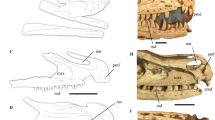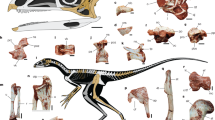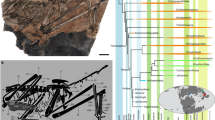Abstract
The relationship between dinosaurs and other reptiles is well established1,2,3,4, but the sequence of acquisition of dinosaurian features has been obscured by the scarcity of fossils with transitional morphologies. The closest extinct relatives of dinosaurs either have highly derived morphologies5,6,7 or are known from poorly preserved8,9 or incomplete material10,11. Here we describe one of the stratigraphically lowest and phylogenetically earliest members of the avian stem lineage (Avemetatarsalia), Teleocrater rhadinus gen. et sp. nov., from the Middle Triassic epoch. The anatomy of T. rhadinus provides key information that unites several enigmatic taxa from across Pangaea into a previously unrecognized clade, Aphanosauria. This clade is the sister taxon of Ornithodira (pterosaurs and birds) and shortens the ghost lineage inferred at the base of Avemetatarsalia. We demonstrate that several anatomical features long thought to characterize Dinosauria and dinosauriforms evolved much earlier, soon after the bird–crocodylian split, and that the earliest avemetatarsalians retained the crocodylian-like ankle morphology and hindlimb proportions of stem archosaurs and early pseudosuchians. Early avemetatarsalians were substantially more species-rich, widely geographically distributed and morphologically diverse than previously recognized. Moreover, several early dinosauromorphs that were previously used as models to understand dinosaur origins may represent specialized forms rather than the ancestral avemetatarsalian morphology.
This is a preview of subscription content, access via your institution
Access options
Access Nature and 54 other Nature Portfolio journals
Get Nature+, our best-value online-access subscription
$29.99 / 30 days
cancel any time
Subscribe to this journal
Receive 51 print issues and online access
$199.00 per year
only $3.90 per issue
Buy this article
- Purchase on Springer Link
- Instant access to full article PDF
Prices may be subject to local taxes which are calculated during checkout



Similar content being viewed by others
References
Benton, M. J. & Clark, J. M. in The Phylogeny and Classification of the Tetrapods. Volume 1: Amphibians, Reptiles, Birds. Systematics Association Special Volume 35A (ed. Benton, M. J. ) 295–338 (Clarendon, 1988)
Gauthier, J. Saurischian monophyly and the origin of birds. Mem. Calif. Acad. Sci . 8, 1–55 (1986)
Sereno, P. C. Basal archosaurs: phylogenetic relationships and functional implications. Soc. Vertebr. Paleontol. Mem. 2, 1–53 (1991)
Sereno, P. C. The evolution of dinosaurs. Science 284, 2137–2147 (1999)
Dalla Vecchia, F. M. in Anatomy, Phylogeny, and Palaeobiology of Early Archosaurs and their Kin Vol. 379 (eds Nesbitt, S. J ., Desojo, J. B . & Irmis, R. B. ) 119–155 (Geological Society, 2013)
Dzik, J. A beaked herbivorous archosaur with dinosaur affinities from the early Late Triassic of Poland. J. Vertebr. Paleontol. 23, 556–574 (2003)
Nesbitt, S. J. et al. Ecologically distinct dinosaurian sister group shows early diversification of Ornithodira. Nature 464, 95–98 (2010)
Benton, M. J. Scleromochlus taylori and the origin of dinosaurs and pterosaurs. Phil. Trans. R. Soc. Lond. B 354, 1423–1446 (1999)
Benton, M. J. & Walker, A. D. Saltopus, a dinosauriform from the Upper Triassic of Scotland. Earth Environ. Sci. Trans. R. Soc. Edinb . 101, 285–299 (2010)
Sereno, P. C. & Arcucci, A. B. Dinosaurian precursors from the Middle Triassic of Argentina: Lagerpeton chanarensis. J. Vertebr. Paleontol . 13, 385–399 (1994)
Sereno, P. C. & Arcucci, A. B. Dinosaurian precursors from the Middle Triassic of Argentina: Marasuchus lilloensis, gen. nov. J. Vertebr. Paleontol. 14, 53–73 (1994)
Bakker, R. T. & Galton, P. M. Dinosaur monophyly and a new class of vertebrates. Nature 248, 168–172 (1974)
Brusatte, S. L. et al. The origin and early radiation of dinosaurs. Earth Sci. Rev. 101, 68–100 (2010)
Langer, M. C., Ezcurra, M. D., Bittencourt, J. S. & Novas, F. E. The origin and early evolution of dinosaurs. Biol. Rev. Camb. Philos. Soc . 85, 55–110 (2010)
Irmis, R. B. et al. A Late Triassic dinosauromorph assemblage from New Mexico and the rise of dinosaurs. Science 317, 358–361 (2007)
Rubidge, B. S. Re-uniting lost continents – fossil reptiles from the ancient Karoo and their wanderlust. S. Afr. J. Geol. 108, 135–172 (2005)
Wopfner, H. Tectonic and climatic events controlling deposition in Tanzanian Karoo basins. J. Afr. Earth Sci. 34, 167–177 (2002)
Sidor, C. A. et al. Provincialization of terrestrial faunas following the end-Permian mass extinction. Proc. Natl Acad. Sci. USA 110, 8129–8133 (2013)
Nesbitt, S. J. The early evolution of archosaurs: relationships and the origin of major clades. Bull. Am. Mus. Nat. Hist. 352, 1–292 (2011)
Ezcurra, M. D. The phylogenetic relationships of basal archosauromorphs, with an emphasis on the systematics of proterosuchian archosauriforms. PeerJ 4, e1778 (2016)
Nesbitt, S. J ., Barrett, P. M ., Werning, S ., Sidor, C. A . & Charig, A. J. The oldest dinosaur? A Middle Triassic dinosauriform from Tanzania. Biol. Lett . 9, 20120949 (2012)
Langer, M. C. & Benton, M. J. Early dinosaurs: a phylogenetic study. J. Syst. Palaeontol. 4, 309–358 (2006)
Padian, K., Horner, J. R. & de Ricqlès, A. Growth in small dinosaurs and pterosaurs: the evolution of archosaurian growth strategies. J. Vertebr. Paleontol. 24, 555–571 (2004)
Kubo, T. & Kubo, M. O. Associated evolution of bipedality and cursoriality among Triassic archosaurs: a phylogenetically controlled evaluation. Paleobiology 38, 474–485 (2012)
Butler, R. J. et al. The sail-backed reptile Ctenosauriscus from the latest Early Triassic of Germany and the timing and biogeography of the early archosaur radiation. PLoS One 6, e25693 (2011)
Butler, R. J. et al. New clade of enigmatic early archosaurs yields insights into early pseudosuchian phylogeny and the biogeography of the archosaur radiation. BMC Evol. Biol. 14, 128 (2014)
Brusatte, S. L., Benton, M. J., Lloyd, G. T., Ruta, M. & Wang, S. C. Macroevolutionary patterns in the evolutionary radiation of archosaurs (Tetrapoda: Diapsida). Earth Environ. Sci. Trans. R. Soc. Edinb . 101, 367–382 (2010)
Brusatte, S. L., Benton, M. J., Ruta, M. & Lloyd, G. T. Superiority, competition, and opportunism in the evolutionary radiation of dinosaurs. Science 321, 1485–1488 (2008)
Lamm, E.-T. in Bone Histology of Fossil Tetrapods: Advancing Methods, Analysis, and Interpretation (eds Padian, K . & Lamm, E.-T. ) 55–160 (Univ. California Press, 2013)
Goloboff, P. A., Farris, J. S. & Nixon, K. C. TNT: a free program for phylogenetic analysis. Cladistics 24, 774–786 (2008)
Goloboff, P. A. & Catalano, S. A. TNT version 1.5, including a full implementation of phylogenetic morphometrics. Cladistics 32, 221–238 (2016)
Niedz´wiedzki, G., Sennikov, A. & Brusatte, S. L. The osteology and systematic position of Dongusuchus efremovi Sennikov, 1988 from the Anisian (Middle Triassic) of Russia. Hist. Biol . 28, 550–570 (2016)
Close, R. A., Friedman, M., Lloyd, G. T. & Benson, R. B. Evidence for a mid-Jurassic adaptive radiation in mammals. Curr. Biol. 25, 2137–2142 (2015)
Lloyd, G. T. Estimating morphological diversity and tempo with discrete character-taxon matrices: implementation, challenges, progress, and future directions. Biol. J. Linn. Soc. 118, 131–151 (2016)
Hamilton, N. ggtern: an extension to ‘ggplot2’, for the creation of ternary diagrams. R package version 2.1.5. https://CRAN.R-project.org/package=ggtern (2016)
R Core Team. R: A language and environment for statistical computing. (R Foundation for Statistical Computing, Vienna, Austria, 2013)
Acknowledgements
We acknowledge A. Tibaijuka for help with fieldwork logistics in Tanzania. Supported by National Geographic Society Research & Exploration grant (9606-14, S.J.N.), National Science Foundation EAR-1337569 (C.A.S.) and EAR-1337291 (K.D.A., S.J.N.), a Marie Curie Career Integration Grant (630123, R.J.B.), a National Geographic Society Young Explorers grant (9467-14 M.D.E.), and the Russian Government Program of Competitive Growth of Kazan Federal University and RFBR 14-04-00185, 17-04-00410 (A.G.S.). We thank S. Chapman, A. C. Milner, M. Lowe and S. Bandyopadhyay for access to specimens, S. Werning, G. Lloyd, R. Close and K. Padian for discussions, and H. Taylor for photographs of the holotype.
Author information
Authors and Affiliations
Contributions
S.J.N., R.J.B., M.D.E. and P.M.B. designed the research project; C.A.S. and K.D.A. designed the field project; S.J.N., C.A.S., K.D.A., R.M.H.S. and M.R.S. conducted fieldwork; S.J.N., R.J.B., M.D.E., P.M.B., M.R.S. and A.J.C. described the material; S.J.N., M.D.E. and M.R.S. conducted the phylogenetic analyses; R.J.B. conducted disparity analyses; and S.J.N., R.J.B., M.D.E., P.M.B., M.R.S., K.D.A., R.M.H.S., C.A.S., G.N. and A.G.S. wrote the manuscript.
Corresponding author
Ethics declarations
Competing interests
The authors declare no competing financial interests.
Additional information
Reviewer Information Nature thanks K. Padian and H.-D. Sues for their contribution to the peer review of this work.
Publisher's note: Springer Nature remains neutral with regard to jurisdictional claims in published maps and institutional affiliations.
Extended data figures and tables
Extended Data Figure 1 Skeletal anatomy of the aphanosaurs Dongusuchus efremovi, Yarasuchus deccanensis and Spondylosoma absconditum.
a, b, D. efremovi. c–t, Y. deccanensis. u–cc, S. absconditum. a, b, Left holotype femur of D. efremovi (Borissiak Paleontological Institute of the Russian Academy of Sciences, Moscow, Russia (PIN) 952/15-1) in posteromedial (a) and anterolateral (b) views. c–e, Right partial femur of Y. deccanensis (Indian Statistical Institute, Kolkata, India (ISIR) unnumbered) in posterolateral (c), proximal (d) and anterolateral (e) views. f, g, Left tibia of Y. deccanensis (ISIR 334) in posterior (f) and distal (g) views. h, i, Left calcaneum of Y. deccanensis (ISIR unnumbered) in proximal (h) and lateral (i) views. j, Second sacral vertebra of Y. deccanensis (ISIR BIA 45/43) in ventral view. k, Right ischium of Y. deccanensis (ISIR 334) in ventrolateral view. l, m, Posterior cervical vertebrae of Y. deccanensis (ISIR BIA 45/43) in posterior (l) and right lateral (m) views. n, o, Right humerus of Y. deccanensis (ISIR 334 53) in anterior (n) and posterior (o) views. p, Right ulna of Y. deccanensis (ISIR 334) in anterior view. q, Trunk vertebra of Y. deccanensis (ISIR BIA 45/43) in left lateral view. r, s, Posterior cervical vertebrae of Y. deccanensis (ISIR BIA 45/43) in posterior (r) and right lateral (s) views. t, Triple-headed rib of Y. deccanensis (ISIR BIA 45) in anterior view. u, x, Original condition (u) of a cervical vertebra (from Huene 1942) of S. absconditum (Paläontologische Sammlung der Universität Tübingen, Tübingen, Germany (GPIT) 479/30) compared to that of the current condition (x). v, w, y, Original condition of a more posterior cervical vertebra of S. absconditum (from Huene 1942) in left lateral (v) and anterior (w) views compared to that of the current condition of the same vertebra in left lateral (y) view. z, Trunk vertebra of S. absconditum in posterior view. aa, Second sacral vertebra of S. absconditum in dorsal view. bb, cc, Right scapula of S. absconditum in lateral (bb) and posterior (cc) views. a., articulates with; ain, anteriorly inclined anterior margin of the neural spine; as, astragalus; ct, calcaneal tuber; dp, deltopectoral crest; fi, fibula; hy, hyposphene; mic, M. iliotrochantericus caudalis scar; mie, M. iliofemoralis externus scar; pr, posterolateral; r, ridge. Scale bars, 1 cm. Outline of Africa and Tanzania obtained from Google Maps.
Extended Data Figure 2 Histological sections of the limb bones of T. rhadinus gen. et sp. nov.
a, Right fibula (NMT RB 488) in lateral (left) and medial (right) views. b, Photo of the histological section of the fibula (NMT RB 488) in regular transmitted light (bright field) (1 plane polarizer). c, Photo of the same section as in b using a full wave retarder (l = 530 nm). d, Left humerus (NMT RB476) in posterior (left) and anterior (right) views. e, Photo of a partial histological section of the humerus (NMT RB476) in regular transmitted light (bright field) (1 plane polarizer). f, Photo of the same section as in e using a full wave retarder (l = 530 nm). Scale bars, 1 mm. Arrows in a, d indicate where each element was sampled. Arrows in b, c, e, f indicate growth marks in the outer cortex.
Extended Data Figure 3 The relationships of T. rhadinus gen. et sp. nov. among archosauriforms from the Nesbitt dataset.
The dataset used has been described in ref. 19. Strict consensus of 36 most parsimonious trees (tree length = 1,374; consistency index = 0.3559; retention index = 0.7807). Bremer support values (first), absolute (second), and GC (third) bootstrap frequencies presented at each branch.
Extended Data Figure 4 The relationships of Teleocrater rhadinus gen. et sp. nov. among archosauriforms from the Ezcurra dataset.
The dataset used has been described in ref. 20. Strict consensus of four most parsimonious trees (tree length = 2,684; consistency index = 0.2955; retention index = 0.6284). Bremer support values (first), absolute (second), and GC (third) bootstrap frequencies presented at each branch.
Extended Data Figure 5 Phylogeny of early Avemetatarsalia illustrating the character distributions of the components of the crocodile-normal ankle configuration and showing that this ankle type was plesiomorphic for Archosauria, Avemetatarsalia, and possible less inclusive clades within Avemetatarsalia (for example, Dinosauriformes).
a, Left calcaneum of the pseudosuchian Nundasuchus songeaensis (NMT RB48). b, Right calcaneum of the aphanosaur T. rhadinus gen. et sp. nov. (reversed) (NMT RB490). c, Left calcaneum of the dinosauriform silesaurid A. kongwe (NMT RB159). Proximal view (left), distal view (middle) and lateral view (right). Scale bars, 1 cm. red, character state present; blue, character state absent; red and blue, basal condition could be either; ?, unknown condition. See Fig. 3 for silhouette sources. 4th, fourth tarsal; a., articulates with; as, astragalus; ct, calcaneal tuber; fi, fibula.
Extended Data Figure 6 Ternary diagrams of measurements of the hindlimb elements (femur, tibia and longest metatarsal) of archosauriforms.
Colour of data points relates to femoral length.
Extended Data Figure 7 The relationships of S. taylori among archosauriforms from the Nesbitt dataset.
The dataset used has been described in ref. 19. Strict consensus of 792 most parsimonious trees (tree length = 1,378; consistency index = 0.3549; retention index = 0.7803) (see Supplementary Information). Bremer support values (first), absolute (second), and GC (third) bootstrap frequencies presented at each branch.
Extended Data Figure 8 The relationships of S. taylori among archosauriforms from the Ezcurra dataset.
The dataset used has been described in ref. 20. Strict consensus of four most parsimonious trees (tree length = 2,693; consistency index = 0.2945; retention index = 0.6280) (see Supplementary Information). Bremer support values (first), absolute (second), and GC (third) bootstrap frequencies presented at each branch.
Extended Data Figure 9 Disparity estimates for major archosaur groups and time intervals (weighted mean pairwise dissimilarity (WMPD)).
Ani, Anisian; C, Changhsingian; Car, Carnian; H, Hettangian; I, Induan; J, Jurassic; Lad, Ladinian; Lo, Lopingian; Nor, Norian; Olen, Olenekian; P, Permian; Rha, Rhaetian.
Extended Data Figure 10 New character illustrations for the phylogenetic analysis.
See Supplementary Information. a–c, Archosaurian iliac comparisons for character 414 in the modified dataset of ref. 19. a, Left ilium of Teleocrater rhadinus (NHMUK PV R6795) in lateral view. b, Right ilium of Asilisaurus kongwe (NMT RB159) in lateral view. c, Left ilium of Batrachotomus kupferzellensis (Staatliches Museum für Naturkunde Stuttgart (SMNS) 80273) in lateral view. d–g, Avemetatarsalian fibula comparisons for character 415 in the modified dataset of ref. 19. d, e, Left fibula of T. rhadinus (NHMUK PV R6795) in lateral (d) and posterior (e) views. f, g, Left fibula of A. kongwe (NMT RB159) in lateral (f) and posterior (g) views. Arrows highlight the posterior ridge, character 415 state 1. h, i, Archosauriform femoral comparisons for character 417 in the modified dataset of ref. 19. h, Right femur of Erythrosuchus africanus (NHMUK PV R3592) in ventral view. i, Right femur of T. rhadinus (NHMUK PV R6795) in posteromedial view. White dotted regions highlight character 417, state 1. j–m, Avemetatarsalian second primordial sacral comparisons for character 416 in the modified dataset of ref. 19. j, k, Second primordial sacral vertebra of T. rhadinus (NMT RB519) in ventral (j) and posterior (k) views. l, m, The second primordial sacral vertebra of A. kongwe (NMT RB159) in ventral (l) and dorsal (m) views. Arrows highlight the posterior process of the sacral rib, character 416, state 1. Scale bars,. 1 cm (a–g, i–m) and 5 cm (h).
Supplementary information
Supplementary Information
This file contains Supplementary Text, Supplementary Tables 1-8 and Supplementary References. (PDF 1167 kb)
Rights and permissions
About this article
Cite this article
Nesbitt, S., Butler, R., Ezcurra, M. et al. The earliest bird-line archosaurs and the assembly of the dinosaur body plan. Nature 544, 484–487 (2017). https://doi.org/10.1038/nature22037
Received:
Accepted:
Published:
Issue Date:
DOI: https://doi.org/10.1038/nature22037
This article is cited by
-
A late-surviving phytosaur from the northern Atlantic rift reveals climate constraints on Triassic reptile biogeography
BMC Ecology and Evolution (2023)
-
Deep reptilian evolutionary roots of a major avian respiratory adaptation
Communications Biology (2023)
-
New reptile shows dinosaurs and pterosaurs evolved among diverse precursors
Nature (2023)
-
A new silesaurid from Carnian beds of Brazil fills a gap in the radiation of avian line archosaurs
Scientific Reports (2023)
-
A colourful view of the origin of dinosaur feathers
Nature (2022)
Comments
By submitting a comment you agree to abide by our Terms and Community Guidelines. If you find something abusive or that does not comply with our terms or guidelines please flag it as inappropriate.



